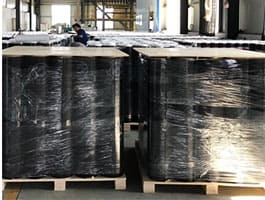Transport

The pallets are covered with a sheet of very thick heat-shrink polythene, but long journeys
on uneven roads and sharp braking can cause the rolls to tip up.
This problem can be avoided by running ropes through the rows of pallets, crosswise to the
width of the bed of the lorry.
The ropes must be properly tightened and suitably protected so that they do not leave marks
on the rolls.
Loading/ Unloading

The material should be stored undercover. The rolls whether covered or uncovered must remain
in a vertical position on a smooth, flat surface, except for
those provided with a rigid core or tube, which can tolerate a horizontal position for a
limited time. Undercover, the panels can be stacked in two layers with lengths of timber
between the layers to spread the weight. Rolls of Thermo base are stored upright in the same
way as the membranes, with the exception of rolls with a selvage which should be arranged
horizontally.
Storage
The material should be stored under cover. The rolls whether covered or uncovered must
remain in a vertical position on a smooth,
flat surface, except for those provided with a rigid core or tube, which can tolerate a
horizontal position for a limited time.
Under cover, the panels can be stacked in two layers with lengths of timber between the
layers to spread the weight.
Rolls of Thermobase are stored upright in the same way as the membranes, with the exception
of rolls with a selvedge which should be arranged horizontally.

On-Site Handling
Keep on-site only the rolls strictly necessary for laying during the day. Set the rolls
upright on a smooth, flat surface. Use a crane to lift the rolls onto the roof, keeping the
pallet complete and intact and using suitable lifting gear. If the packs have to be opened
and the rolls lifted loose, use suitable lifting gear with the crane and in any event set
the rolls upright after lifting. Do not use ropes to tie and lift the rolls.

Conservation
It is advisable to store the pallets in a dry place, sheltered from the sun. In the summertime, because of the greenhouse effect, pallets with heat-shrink wrapping exposed to the sun quickly reach a temperature of around 70°C and this causes progressive blackening from the top downwards of the talc coating or mineral granules on the rolls, until the point where the coils on the roll stick together or at any rate take on an unpleasant aesthetic appearance. In the case of membranes reinforced with polyester non-woven fabric, the heat also causes the ends of the rolls to begin to shrink and thus wrecks the membrane.

It should also be borne in mind that exposure to heat, as is well known, causes progressive and predictable loss of flexibility, but if what happens naturally in use happens instead to material still on the roll, it is possible that cracking problems or difficulty unrolling the material may occur.
In winter the rolls should be stored for 24 hours at a temperature above +5°C before laying. Avoid leaving the rolls in the open overnight. Only the rolls which will be applied during the day should be brought onto the site. A good rule is always to "rotate" the stock and not to keep rolls for more than 12 months.

